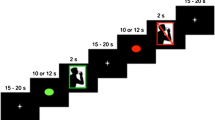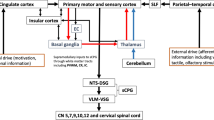Abstract
Objective: This research sought to identify a well-defined pre-motor potential, the Bereitschaftspotential (BP), as a manifestation of cortical contribution to the pre-motor planning of volitional swallowing. Methods: EEG data were collected from 20 research participants during volitional execution of swallowing and finger movement tasks. A 5 second pre-movement epoch for each task was triggered on EMG identification of movement onset. A grand average for each task representing approximately 2400 trials across all research participants was derived to compare and contrast morphological features of the derived waveform. Results: Volitional pharyngeal swallowing and finger movement generated similar waveform characteristics of duration and slope; however, statistically significant differences were identified in polarity and in amplitude at four points both early and late in the epoch. Additionally, swallowing produced a pre-motor waveform with a rapid declination of EEG activity in the final 500 msec prior to movement onset. Conclusions: This study demonstrates activation of the supplementary motor cortex preceding the onset of volitional swallowing. However, unlike purely voluntary movements, the volitional pharyngeal swallowing task, as assessed with this methodology, does not appear to recruit the primary motor cortex. Thus engagement of the swallowing response appears to rely on indirect parallel pathways between extrapyramidal cortical motor planning regions and lower motor neurons.
Similar content being viewed by others
References
Amri, M., Car, A. and Jean, A. Medullary control of the pontine swallowing neurones in sheep. Exp. Brain Res., 1984, 55: 105–110.
Barlow, S.M., Farley G.R. and Andreatta, R.D. Neural systems in speech physiology. In: S. Barlow (Ed.), Handbook of Clinical Speech Physiology. San Diego, Singular Publishing Group, 1999: 101–163.
Birn, R.M., Bandettini, P.A., Cox, R.W. and Shaker, R. Event-related fMRI of tasks involving brief motion. Human Brain Map., 1999, 7: 106–114.
Birn, R.M., Bandettini, P.A., Cox, R.W., Jesmanowicz, A. and Shaker, R. Magnetic field changes in the human brain due to swallowing or speaking. Magn. Reson. Med., 1998, 40(1): 55–60.
Blair, R.C. and Karniski, W. Distribution-free statistical analyses of surface and volumetric maps. In: R.W. Thatcher, M. Hallett, T. Zeffiro, R. John and M. Huerta (Eds.), Functional Neuroimaging: Technical Foundations. San Diego, Academic Press, 1994: 19–29.
Boschert, J. and Deecke, L. Comparative investigation of cerebral potentials related to toe and finger movements. Cerebral psychophysiology: Studies in event related potentials. Electroencephalography Suppl., 1986, 38: 235–237.
Car, A., Jean, A. and Roman, C. A pontine primary relay for ascending projections of the superior laryngeal nerve. Exp. Brain Res., 1975, 22: 197–210.
Chisholm, R.C. and Karrer, R. Associated movement, motor control and the readiness potential. Cerebral psychophysiology: Studies in event related potentials. Electroencephalography Suppl., 1986, 38: 242–244.
Cui, R.Q. and Deecke, L. High resolution DC-EEG analysis of the Bereitschaftspotential and post movement onset potentials accompanying uni-or bilateral voluntary finger movements. Brain Topography, 1999, 11: 233–249.
Cui, R.Q., Huter, D., Lang, W., Lindinger, G., Beisteiner, R. and Deecke, L. Multichannel DC current source density mapping of the Bereitschaftspotential in the supplementary and primary motor area preceding differently loaded movements. Brain Topography, 1993, 9: 83–94.
Cui, R.O., Huter, D., Lang, W. and Deecke, L. Neuroimage of voluntary movement: Topography of the Bereitschaftspotential, a 64-channel DC current source density study. NeuroImage, 1999, 9: 124–134.
Daniels, S.K. and Foundas, A.L. The role of the insular cortex in dysphagia. Dysphagia, 1997, 12(3): 146–156.
Deecke, L. and Kornuber, H.H. Anelectrical signal of participation of the mesial supplementary motor cortex in human voluntary finger movement. Brain Res., 1978, 159: 473–476.
Deecke, L., Engel, M., Lang, W. and Kornhuber, H.H. Bereitschaftspotential preceding speech after breath holding. Exp. Brain Res., 1986, 65: 219–223.
Deecke, L., Grozinger, B. and Kornhuber, H.H. Voluntary finger movement in man: cerebral potentials and theory. Biological Cybernetics, 1976, 23: 99–119.
Deecke, L., Kornhuber, H.H., Lang, W., Lang, M. and Schreiber, H. Timing function of the frontal cortex in sequential motor and learning tasks. Human Neurobiology, 1985, 4(3): 143–154.
Deecke, L., Scheid, P. and Kornhuber, H.H. Distribution of readiness potential, pre-motion positivity and motor potentials of the human cerebral cortex preceding voluntary finger movements. Exp. Brain Res., 1969, 7: 158–168.
Doty, R.W. Neural organization of deglutition. In: C.F. Code (Ed.) Handbook of Physiology, Vol 4-6, Motility: Alimentary Canal. Washington, D.C., Am Physiol. Soc., 1968: 1861–1902.
Doty, R.W., Rochmond, W.H. and Storey, A.T. Effect of medullary lesions on coordination of deglutition. Exp. Neurol., 1967, 17: 91–106.
Fetz, E.E., Cheney, P.D. and German, D.C. Corticomotoneuronal connections of precentral cells detected by post spike averages of EMGactivity in behaving monkeys. Brain Research, 1976, 114: 505–510.
Ghez, C. Introduction to Motor Systems. In E.R. Kandel and J.H. Schwartz (Eds.), Principles of Neuroscience, 2nd Edition, New York, Elsevier, 1985: 429–442.
Hamdy, S., Aziz, Q., Rothwell, J.C., Crone, R., Hughes, D.G., Tallis, R.C. and Thompson, D.G. Explaining oropharyngeal dysphagia after unilateral hemispheric stroke. Lancet, 1997a, 350: 686–692.
Hamdy, S., Aziz, Q., Rothwell, J.C., Hobson, A., Barlow, J. and Thompson, D.G. Cranial nerve modulation of human cortical swallowing motor pathways. Am. Physiol. Soc., 1997b: G802–G808.
Hamdy,S., Mikulis, D.J., Crawley, A., Xue, S., Lau, H., Henry, S. and Diamant, N.E. Cortical activation during human volitional swallowing: an event-related study. Am. J. Physiol., 1999a, 277(1:1): G219–G225.
Hamdy, S., Rothwell, J.C., Brooks, D.J., Bailey, D., Azis, Q. and Thompson, D.G. Identification of the cerebral loci processing human swallowing with H215O PET activation. J. Neurophysiol., 1999b, 81: 1917–1926.
Hiiemae, K. The sounds of swallowing: a preliminary methodological investigation. Second workshop on cervical auscultation. Tysons Corner, VA, 1994.
Hughes, T.A.T. and Wiles, C.M. Clinical measurement of swallowing in health and in neurogenic dysphagia. Q. J. Med., 1996, 89: 109–116.
Ikeda, A., Luders, H.O., Burgess, R.C., Sakamoto, A.M., Klem, G.H., Morris, H.H. and Shibasaki, H. Movement related potentials associated with single and repetitive movements recorded from the human supplementary motor area. Electroenceph. Clin. Neurophysiol., 1993, 89(4): 269–277.
Jasper, H.H. The ten-twenty electrode system of the international federation. Electroenceph. Clin. Neurophysiol., 1958, 10: 371–375.
Jean, A. Brainstem organization of the swallowing network. Brain Behav. Evol., 1984, 25: 109–116.
Jean, A. Control of the central swallowing program by inputs from the peripheral receptors: A review. J. Auton. Nervous System, 1986, 10: 225–233.
Jean, A. Brainstem control of swallowing: localization and organization of the central pattern generator for swallowing. In: A. Taylor (Ed.), Neurophysiology of the Jaws and Teeth. London, MacMillan Press, 1990.
Karniski, W., Blair, B.C. and Snider, A.D. An exact statistical method for comparing topographic maps with any number of subjects and electrodes. Brain Topography, 1994, 6(3): 203–210.
Kornhuber, H.H. and Deecke, L. Hirnpotentialanderungen bei willkurbewegungen und passive bewegungen des menschen: Bereitschaftspotential und reafferent potentiale. Pflugers. Arch., 1965, 284: 1–17.
Kristeva, R., Cheyne, D., Lang, W., Lindinger, G. and Deecke, L. Movement-related potentials accompanying unilateral and bilateral finger movements with different inertial loads. Electroencep. Clin. Neurophysio., 1990, 75(5): 410–418.
Kubota, K. Motoneurone mechanisms: Suprasegmental controls. In: B.J. Sessle and A.G. Hannam (Eds.), Mastication and Swallowing. Biological and Clinical Correlates. Toronto, University of Toronto Press, 1976: 60–75.
Lang, W., Lang, M., Uhl, F., Koska, C., Kornhuber, A. and Deecke, L. Negative cortical DC shifts preceding and accompanying simultaneous and sequential finger movements. Exp. Brain Res., 1988, 71(3): 579–587.
Lang, W., Cheyne, D., Kristeva, R., Lindinger, G. and Deecke, L. Functional localization of motor processes in the human cortex. Electroenceph. Clin. Neurophysiol., 1991, 42: 97–115.
Lindinger, G., Svasek, P., Lang, W. and Deecke, L. PC-supported 64-channel DC-EEG amplifier. In: K.P. Adlassnig, G. Grabner, S. Bengtsson, and R. Hansen (Eds.), Lecture Notes in Medical Informatics. Berlin, Springer, 1991: 1005–1009.
Lund, J.P. and Enomoto, S. The generation of mastication by the mammalian central nervous system. In: A.H. Cohen, R. Rossignol, and S. Grillner (Eds.), Neural control of rhythmic movements in vertebrates. New York, John Wiley, 1988: 41–72.
Luschei, E.S. and Goldberg, L.J. Neural mechanisms of mandibular control: mastication and voluntary biting. In: Handbook of physiology: Vol. 2. The nervous system. Motor control. Bethesda MD, American Psychological Society, 1981: 1237–1274.
Macpherson, J., Wiesendanger, M., Marangoz, C. and Miles, T.S. Corticospinal neurones of the supplementary motor area of monkeys. Exp. Brain Res., 1982, 48: 81–88.
McAdam, D.W. The contingent negative variation. In: R.F. Thompson and M. M. Patterson (Eds.), Bioelectric Recording Techniques. NewYork: Academic Press, 1974: 205–218.
Meadows, J.C. Dysphagia in unilateral cerebral lesions. J. Neurol. Neurosurg. Psych., 1973, 36: 853–860.
Mesulum, M.M. and Mufson, E.J. The insula of Reil in man and monkey: Architectonics, connectivity, and function. In: A. Peters and E.G. Jones (Eds.), Cerebral Cortex: Association and Auditory Cortices. New York, Plenum Press, 1985: 179–226.
Miller, A.J. The Neuroscientific Principles of Swallowing. San Diego, Singular, 1999.
Miller, A.J. and Bowman, J.P. Precentral cortical modulation of mastication and swallowing. J. Dent. Res., 1977, 56: 1154.
Misulis, K.E. Spehlmanns Evoked Potential Primer: Visual, Auditory and Somatosensory Evoked Potentials in Clinical Diagnosis. Newton, MA, Butterworth-Heinemann, 1994.
Mosier, K., Patel, R., Lui, W., Kalnin, A., Maldjian, J. and Baredes, S. Cortical representation of swallowing in normal adults: functional implications. Laryngoscope, 1999, 109: 1417–1423.
Oldfield, R.C. The assessment and analysis of handedness: the Edinburgh inventory. Neuropsychologia, 1971, 9(1): 97–113.
Orgogozo, J.M. and Larsen, B. Activation of the SMA during voluntary movements in man suggests it works as a supramotor area. Science, 1979, 206: 847–850.
Parent, A. Carpenters Human Neuroanatomy. 9th ed. Baltimore, Williams and Wilkins, 1996.
Regan, D. Human brain electrophysiology: evoked potentials and evoked magnetic fields in science and medicine. New York, Elsevier, 1989.
Rektor, I., Feve, A., Buser, P., Bathien, N. and Lamarche, M. Intra-cerebral recordings of movement related readiness potentials: an exploration in epileptic patients. Electroenceph. Clin. Neurophysiol., 1994, 90: 273–283.
Robbins, J. and Levine, R.L. Swallowing after unilateral stroke of the cerebral cortex: Preliminary evidence. Dysphagia, 1980, 3: 11–17.
Roland, P.E., Larsen, B., Lassen, N.A. and Skinhoj, E. SMA and other cortical areas in organization of voluntary movement in man. J. Neurophysiol., 1980, 43: 118–136.
Shibasaki, H., Barrett, G., Halliday, E. and Halliday, A.M.Components of the movement-related cortical potentials and their scalp topography. Electroenceph. Clin. Neurophysiol., 1980, 49: 213–226.
Shipley, M.T. Insular cortex projections to the nucleus of the solitary tract and brainstem visceromotor regions in the mouse. Brain Res. Bull., 1982, 8: 139–148.
Zald, D.H. and Pardo, J.V. The functional neuroanatomy of voluntary swallowing. Anal. Neurol., 1999, 46(3): 281–285.
Author information
Authors and Affiliations
Rights and permissions
About this article
Cite this article
Huckabee, ML., Deecke, L., Cannito, M.P. et al. Cortical Control Mechanisms in Volitional Swallowing: The Bereitschaftspotential. Brain Topogr 16, 3–17 (2003). https://doi.org/10.1023/A:1025671914949
Issue Date:
DOI: https://doi.org/10.1023/A:1025671914949




